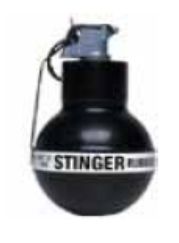No. 15 Sting Ball Grenade
|
The Sting Ball Grenade may be used for crowd control, personnel incapacitation, or to clear facilities of personnel. After detonation, the rubber pellets rapidly lose velocity. Individuals struck by the pellets at long range are unlikely to notice anything or suffer any injury. Within 50 feet of the detonation, however, individuals usually notice an intense stinging at the site of impact. Because of the relatively low velocity and the character of the projectile (rubber), penetration beneath the skin is not usually expected. For those close to the site of detonation, however, penetration of the pellets beneath the skin is common. Superficial penetration is treated by removal of the pellet, debridement of any dead tissue (rarely needed), thorough cleansing of the wound tract with large amounts of sterile saline, Ringer's lactate, or even plain water. Make sure to remove any foreign material (clothing threads, dirt). Then apply a loose gauze, and allow the wound to close spontaneously. Skin edges should not be primarily sutured. Administer tetanus prophylaxis. Deep penetration is treated just like any other low to moderate velocity penetrating wound from a foreign body. Any pellet injury to the eye can be very serious and vision-threatening. If the operational setting allows, immobilize the eye (patching or eye cup) and arrange for transportation to a definitive care setting. |
From Operational Medicine 2001: Health Care in Military Settings
CAPT Michael John Hughey, MC, USNR
NAVMED P-5139
January 1, 2001
Bureau of Medicine and
Surgery,
Department of the Navy,
2300 E Street NW,
Washington, D.C,
20372-5300
United States Special Operations Command,
7701 Tampa Point Blvd.,
MacDill AFB, Florida,
33621-5323
Home · Textbooks and Manuals · Videos · Lectures · Distance Learning · Training · Operational Safety · Search
This website is dedicated to the development and dissemination of medical information that may be useful to those who practice Operational Medicine. This website is privately-held and not connected to any governmental agency. The views expressed here are those of the authors, and unless otherwise noted, do not necessarily reflect the views of
the Brookside Associates, Ltd., any governmental or private organizations. All writings, discussions, and publications on this website are unclassified.
© 2006 Medical Education Division, Brookside Associates, Ltd. All rights reserved
 This hand-held, hand-thrown grenade has an initial 1-second delay fuse, after which
the fuse assembly is discharged at low speed away from the main charge. After an
additional 1-second delay, the main charge detonates. This produces a loud
sound, a bright flash of light, and the distribution of approximately 180 rubber
pellets of .32 caliber size. Pellets travel up to 50 feet from the point of
detonation.
This hand-held, hand-thrown grenade has an initial 1-second delay fuse, after which
the fuse assembly is discharged at low speed away from the main charge. After an
additional 1-second delay, the main charge detonates. This produces a loud
sound, a bright flash of light, and the distribution of approximately 180 rubber
pellets of .32 caliber size. Pellets travel up to 50 feet from the point of
detonation.